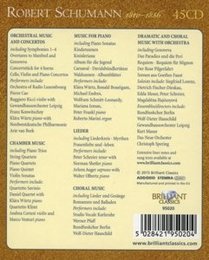| All Artists: Various Artists Title: Schumann Edition Members Wishing: 0 Total Copies: 0 Label: Brilliant Classics Release Date: 10/30/2015 Album Type: Box set Genre: Classical Style: Number of Discs: 45 SwapaCD Credits: 45 UPC: 762183062526 |
Search - Various Artists :: Schumann Edition
 | Various Artists Schumann Edition Genre: Classical Robert Schumann is perhaps best remembered for two things: the sheer number of his compositions, particularly his piano music, produced in his relatively short life; and his passionate and deeply tumultuous... more » |
Larger Image |
CD Details
Synopsis
Product Description
Robert Schumann is perhaps best remembered for two things: the sheer number of his compositions, particularly his piano music, produced in his relatively short life; and his passionate and deeply tumultuous relationship with Clara Schumann, née Wieck, his highly accomplished pianist wife. Schumanns life was clouded with episodes of depression and emotional turmoil, to the extent that he spent the last two years of his life in an asylum, tormented by incidents of paranoia and delusion, as well as a fading memory. Despite or maybe because of his turbulent emotional state, Schumann managed to complete hundreds of compositions, from expansive orchestral works to tender Lieder and even a fully fledged opera. Schumann found inspiration at different points in his life to write for different forces. The year 1840 became known as his Lieder year, and among his many inspired compositions was the cycle Frauenliebe und leben, a compelling account of a womans life and love. In 1841, not long after marrying Clara, he was inspired by her encouragement to start writing for orchestra. He composed his first Symphony (Spring) in February of that year, later sketching his Overture, Scherzo and Finale Op.52 in April/May and composing what would become the Piano Concerto in May. In the same year he completed his D minor Symphony, though he wouldnt publish it for another ten years, making it his Fourth. The next year would come to be known as his Chamber Music year; despite struggling with resentment that Claras popularity as a pianist was outstripping his own as a composer, Schumann managed to turn his unhappiness into a productive spell of composition. In February 1842 he began the first two String Quartets, finishing them off in the summer, and in July he composed his third. The Piano Quintet was written in October, and November saw him working on the Piano Quartet. This highly productive period saw the composer exploring a range of styles, with intricate fugues as well as lighter motifs taken from Haydn and Mozart. In 1843 Schumann began working on oratorios, including Das Paradies und die Peri, but his true ambition was to write an opera. Unimpressed with Wagners offerings, Schumann spent a lot of time in thought before settling on the medieval tale of Genoveva for his first operatic work, completed in 1848. The opera is far removed from the vast forces required for Wagner; the work is a scene opera, characterised by recitative style phrasing and a sumptuously lyrical orchestral score. Throughout his life Schumann composed for the piano, inspired at first by his forbidden love for Clara (only receiving permission to marry her in 1840 after a long legal battle). His piano compositions continued well into the latter stages of his life, even during his time in the asylum. 14 of the 45 recordings on this release are dedicated to Schumanns solo piano music, not to mention his intricate writing for the Piano Concerto and piano chamber works. Among the many singers featured are Arleen Auger, one of the most highly regarded sopranos of the 20th century, who performs the magnificent Frauenliebe und leben, as well as Peter Schreier, who focuses on Lieder penned by Heinrich Heine. Newer recordings include Schumanns chamber works, performed by Quartetto Savinio described by La Repubblica as the heirs to the Quartetto Italiano along with Quartetto Klimt and the Daniel Quartet.


![Dvoák Edition [Box Set]](https://nationalbookswap.com/cd//m/43/9943/13329943.jpg)

